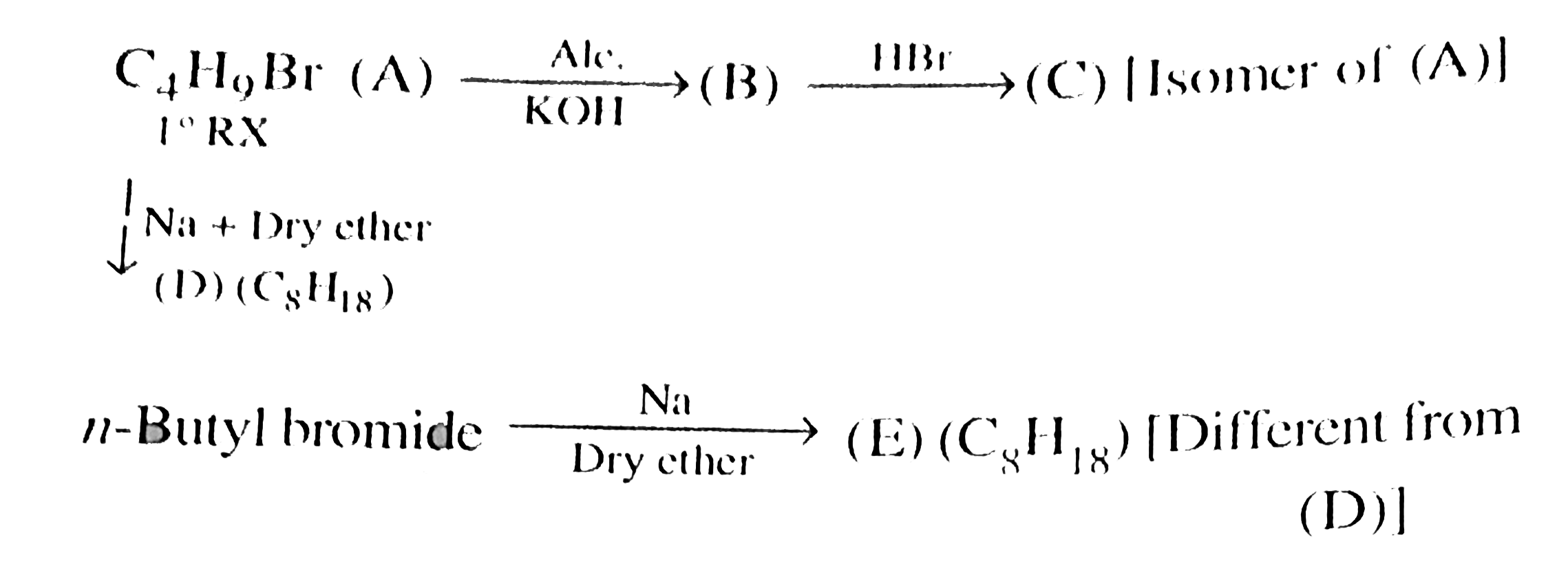Complete Solutions to Exercises Concept Application of chapter AROMATIC COMPOUNDS AND ALKYL AND ARYL HALIDES of Class 12 book with complete answers and questions
| Class 12 | CHEMISTRY |
| Chapter | AROMATIC COMPOUNDS AND ALKYL AND ARYL HALIDES |
| CENGAGE CHEMISTRY | Exercises Concept Application |
| Number Of Questions | 4 |
| Academic Year | 2023-24 |
How will you bring about the following conversations in not more than two steps?
a. Ethanlol to but `-1` yne
b. Ethnee to bromoethene
c. Propene to `1-` Nitropropane
d. Toluene to benzyl alchol
e. Propane to propyne
f. Ethanol to ethyl fluoride
g. Bromomethane to prepanone
h. But `-1-ene` to but `-2-ene`
i. `1-` Chlorobutane to `n-` octane
j. Bromocethane to cis-hex `-3-` ene
k. Benyl alchol to phenylethanenitrile
l. Benzene to biphenyl
m. Cyclopentene to cycolpentya `-1,3-` diene
n. Anline to phenyl isocyanideView Solutiona. A sample of `0.50g` of an organic compound was treated according to Kjeldahal's method. The ammonia evolved was aboserved in `50 ml` of `0.5M H_(2)SO_(4)`. The residual acid required `60 mL` of `0.5M` solution of `NaOH` for neutralisation. Find the percentage composition of hnitrogen in the compound.
b. On analysis, `0.2g` of a monobasic acid gave `0.505 gm` of `CO_(2)` and `0.0864gm H_(2)O. 0.305 gm` of this acid required `25 ml` of `M//10 NaOH` solution for neutralisaton. Find the molecular formula of the acid.
c. A liquid aromatic organcvi compound `(A)` conatining carbon `(92.3%)` and hydrogen `(7.7%)` decoluidsed `KMnO_(4)` and on ozonolysis gave methanal and another compound `(B)`. The molecular mass of `(A)` is `104`. On treatment with a suitable catalyisis, `(A)` gave a high molecular mass solid product `(C)` having the same empirical formula as that of compound `(A)`. Compound `(C)` is used in making toys and household goods. Identify `(A),(B)`, and `(C)` and explain the reactions.
d. A sample of `0.246 gm` of an organic compound gave `0.198 gm` fo `CO_(2)` and `0.104 gm` of `H_(2)O` on complete combusion. `.37gm` of the compound gave `0.638 gm` of silver bromide in Carius method. What is the molecular formula of the compound if its molecular mass is `109`.View SolutionConvert the following:
a, `t-` Butyl chloride to isobutyl bromide
b. Chloroentane to butane
c. `2-` Chloropropane to `1-` bromopropane
d. Bromo benzene to `p-` nitrophenol
e. Isopropyl alchol to iodofrom
f. `2-` Chloropropane to `1-` Propanal
g. Butene to `n-` butyl iodite
h. Ethyl bromide to propanoic acid.
i. `2-` Methyl prop `-1` ene to `2-` Chloro `-2-` methyl propane
j. `2-` Bromonbutane to `3,4-` dimethyl hexane
k. Anline to propane nitrile
m. Benzyl alcohol to phenyl ethonaic acid
n. Benzene to `4-` bromo nitro benzene
o. Toulene t benzyl alchohol
p. `I-` Bromopropane to `2-` bromobnpropane
q. Ethanol to but `-1-` yne
r. Propane to propan `-1-ol`View SolutionIdentify `(A)` to `(E):`
 08:35View Solution
08:35View Solution
Exercises Concept Application questions and complete solutions for chapter AROMATIC COMPOUNDS AND ALKYL AND ARYL HALIDES of CENGAGE CHEMISTRY (HINGLISH) of Class 12
All Exercises from CENGAGE CHEMISTRY Class 12 CHEMISTRY AROMATIC COMPOUNDS AND ALKYL AND ARYL HALIDES
- Archives Assertion-Resoning
- Archives Fill In Theblanks
- Archives Mutiple Correct
- Archives Mutiple Correct Answers Type
- Archives Single Correct
- Archives Single Correct Answer Type
- Archives Subjective
- Archives Subjective Type
- Exercises Assertion-Resoning
- Exercises Assertion-Resoning Type
- Exercises Concept Application
- Exercises Concept Application Type
- Exercises Linked Compreshension
- Exercises Linked Compreshension Type
- Exercises Multiple Correct
- Exercises Multiple Correct Answers Type
- Exercises Single Correct
- Exercises Single Correct Answer Type
- Exercises Subjective
- Exercises Subjective Type
- Illustration
- Solved Examples
- Solved Problems
